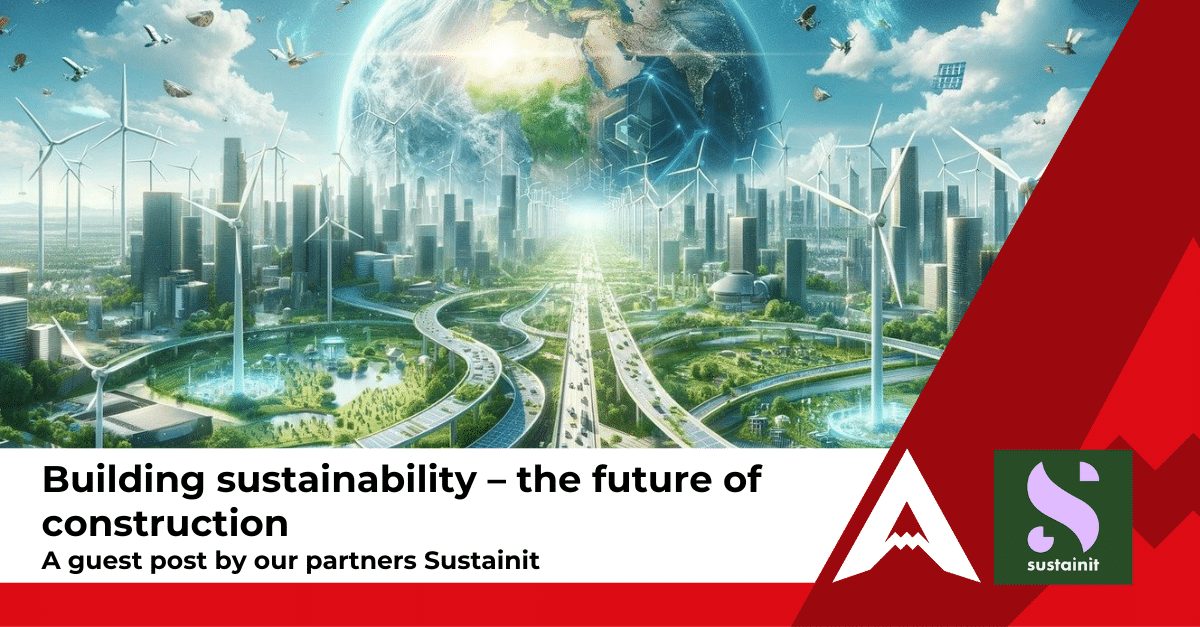
About Sustainit
Sustainit is an award-winning sustainability data consultancy. With expertise in sustainability data reporting, data management software and impact consulting, they aim to revolutionise how organisations make a positive impact – one data point at a time. Take a look at their website to find out more about what they do
Introduction
Sustainability is no longer just a buzzword – it’s a core component of the construction industry. The demand for sustainable buildings and infrastructure is higher than ever, driven by the climate crisis, declining resources, and a global call for greener, more responsible practices.
The built environment accounts for 40% of UK greenhouse gas emissions1. Infrastructure development and usage, such as power plants, buildings, and transportation, are major contributors to this statistic. Yet in the cyclical nature of the climate crisis, climate risk also poses a threat to construction.
The journey towards sustainability might seem daunting, but it’s also full of opportunities for innovation and development. By aligning with Net Zero, Circular Economy and Nature Positive principles, you can embrace the sustainable future of construction.
The future of construction
Net Zero emissions
The UK’s commitment to reach net-zero carbon emissions by 2050 is no small feat. Achieving this target requires a holistic transformation of the construction industry. Recognising the mandate of this transformation, the Royal Institute of Chartered Surveyors, in collaboration with industry peers, has produced standards and assessments making it easier to benchmark progress towards Net Zero in the built environment2. Similarly, the UK Government’s Future Homes Standard sets a plan to decarbonise all new-build homes as of 2025, setting new standards for energy efficiency and low-carbon heating3. To accelerate the decarbonisation of UK homes, construction companies are expected to heavily invest in R&D projects aimed to provide innovative solutions, materials, and technologies to the industry. R&D tax relief could allow these companies to recover a portion of their investments in innovation and save thousands of pounds to reinvest in further R&D projects.
The circular economy transition
The circular economy has disrupted traditional linear models of production and consumption. For construction firms, this means transitioning from a ‘take-make-dispose’ model to one that emphasises recycling, reuse, and waste reduction. This approach is being widely adopted and is recommended by the 80 organisations behind Our Shared Understanding4. This collective, including the National Infrastructure Commission, calls to action the necessity of a transition to a circular economy across the construction supply chain5.
Nature positive construction
Sustainable construction goes beyond bricks and mortar; it considers the impact of construction on natural environments. The recently released UK Green Infrastructure Framework encourages the integration of green spaces in urban development6. Working hand in hand with this framework is the Biodiversity Net Gain (BNG) requirement, which will set a minimum requirement for a 10% net gain in biodiversity for new developments7. Projects should incorporate habitat restoration, green corridors, and sustainable landscaping to comply with the requirements. Embracing nature positivity in construction is a legal, strategic and moral imperative.
In the pursuit of net-zero goals, circular economy principles, and nature-positive construction, research and development (R&D) plays a pivotal role. Businesses are increasingly turning to R&D to create sustainable building materials that align with these objectives. For example:
- Low carbon materials – Developing materials that have a significantly lower carbon footprint (compared to traditional alternatives) can be used in construction to reduce emissions and align with net-zero goals.
- Recycled materials – There has been a large focus on creating materials from recycled resources, as well as being easily recyclable and reusable themselves. This can help contribute to reducing waste and conserving resources in a shift towards the circular economy.
- Nature-friendly materials – Research and development can drive innovation in materials that not only eliminate toxicity but also actively contribute to the restoration of the natural environment (e.g. bee-friendly bricks).
In developing and implementing these sustainable building materials, businesses can take huge strides toward their net-zero, circular economy, and nature-positive goals. This innovation not only benefits the environment but also positions companies as leaders in the transition to a greener, more sustainable construction industry.
For companies pushing the boundaries of innovation in the construction industry, tax relief could be available to reduce the cost of their R&D projects. For projects that meet the criteria of R&D for tax purposes, companies can recover a percentage of their staffing costs, costs associated with prototyping and testing, software costs, and even the costs of contracted companies undertaking work contributing to the R&D project.
At Apogee, we understand that time constraints and the complexity of HMRC’s guidelines are barriers to the R&D incentive for many companies. For this reason, working with experts with several years of experience in R&D tax relief, such as Apogee, gives reassurance that your claim is in good hands and saves you time.
Leveraging your sustainability data
To truly embrace innovation and sustainable practices demanded by legislation and stakeholders, it’s crucial to be able to map and manage your data. Being able to see where your impact lies will allow you to direct your research and development efforts to work towards a sustainable future. This might require a materiality assessment, value chain analysis or carbon footprint calculations. Requiring skilled resource, this can be a difficult and time-consuming process. But get it right and you’ll be ahead of your competitors.
- In an age of increasing environmental consciousness, clients and investors are demanding sustainability data to evidence a company’s commitment to sustainability.
- With the right expertise, you can quickly spot areas for innovation and develop a long-term sustainability strategy.
- Having a robust strategy futureproofs your business and paves the way for maximising positive impact on the environment through R&D.
Armed with data-driven insights and tools accompanying a clear understanding of your impact, you can lead the way in sustainable construction.
Get in touch to arrange a chat and see how Sustainit can support your organisation on its journey to sustainability.
References:
- Government Commercial Function – Net zero carbon in construction
- RICS – Sustainable construction infrastructure
- Future Homes – Future Homes Standard
- Our Shared Understanding – Circular built environment
- National Infrastructure Commission – A sustainable approach
- Natural England – Green infrastructure
- Gov UK – Understanding Biodiversity Net Gain


